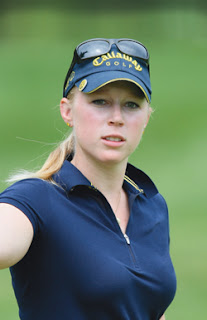 |
| photo courtesy of the course |
Ballyowen is the crown jewel of the Crystal Springs Resort collection of seven golf courses in the New Jersey highlands. The links-style design by Roger Rulewich has won accolades from Golfweek and many other publications, all well-deserved. You may argue whether it's like playing a links course (it's not), but you can't disagree with the simple fact that Ballyowen is an excellent test of your golf game.
The course sprawls over 250 acres atop a plateau surrounded by rolling farmland and craggy knolls giving it a wide-open, wind-swept feel. It is virtually treeless and fairways are defined by yellow fescue and other native grasses that literally eat errant shots, further giving the course a Celtic feel. Both greens and fairways are generally wide and welcoming, however, so well-played shots are rewarded. Just don't expect much links-like roll from the lush fairways.
Ballyowen measures 6,508 from the gold tees, which is as far back as all but the pros should play. With a 71.5 rating and 130 slope, the gold tees provide plenty of challenge. There are five sets of tees in total, ranging from 7,094 to 4,903 yards.
Birdie opportunities abound for the player who can keep their ball out of the gnarly rough and put it in the right place on the sprawling greens. Only two of the par fours are over 400 yards, two of the par fives are under 500 yards, and the longest par three is 180. It's the accuracy of your approach shots that will make the difference on even the two short par fours (#2 at 312 yards and #12 at 328) since neither one is drive-able.
The longest par five, the third hole clocking in at 546 yards, is a fascinating three-shot test, playing uphill on the approach and generally into the wind. The fairway is serpentine with bunkers guarding every turn and impossible rough lurking not far off the line. Aim right off the tee to bring the landing area for your second shot into view. A massive bunker--nearly fifty yards long--splits the fairway directly in front of the green, so make the right strategic choice on your second shot to set up your third.
The sixth hole, a 174-yard par three, is a card-wrecker that comes early in the round. The tee shot is all carry over water, which also wraps around the right side of the monstrous green. There's not really any bail-out area, either: the left side of the green is home to a huge bunker. Even if you avoid all the trouble, just landing your ball on the wide but shallow green doesn't guarantee a par since you could easily have a first putt of well over 100 feet.
Speaking of demanding putts, watch out for the the eleventh hole, a seemingly benign 161-yard one-shotter. You absolutely must put your tee shot on the same level as the cup on one of the three severe tiers to avoid a near-certain three jack--or worse.
 |
| The Back Nine At Ballyowen. Photo courtesy of the course. |
Ballyowen's sixteenth hole brings together all the challenges you've faced so far. At 420 yards, it requires an accurate drive with a forced carry over the fescue to a fairway pinched by two gleaming bunkers on the right. Your second shot will be uphill to a long, narrow green guarded by a false front and yet more bunkers on both sides. The green itself is a roller-coaster ride where double-breakers are normal.
Ballyowen may not play like a links course, but it feels like one. Fairways are surrounded by mounds and hillocks and the big, big greens invite long running chips and pitches. The wide-open layout and views of the golf course around you reminded me of Kingsbarns Golf Links southeast of St. Andrews, where every time you look up after your own shot you can see other golfers in the distance. It's a course well worth the day trip from New York or Westchester or even a golf weekend where you can sample some of the other attractions--including the six other courses--within the Crystal Springs community.
Among many other books, Dave Donelson is the author of
Weird Golf: 18 tales of fantastic, horrific, scientifically impossible, and morally reprehensible golf








